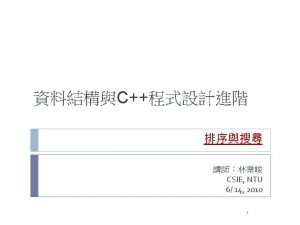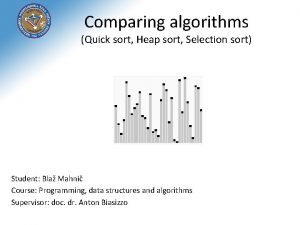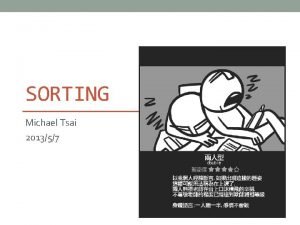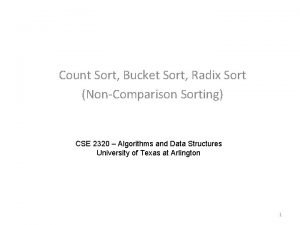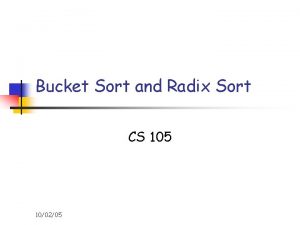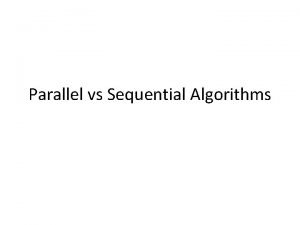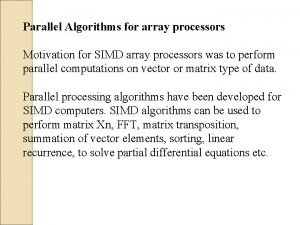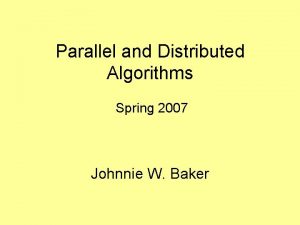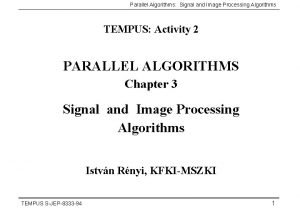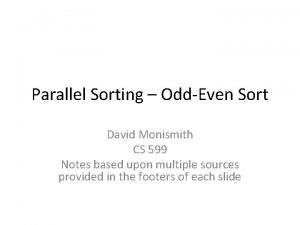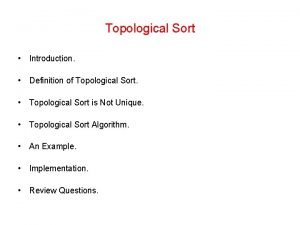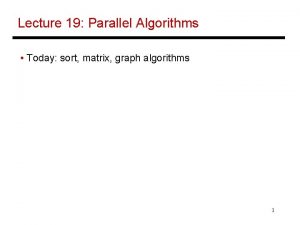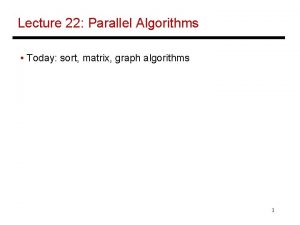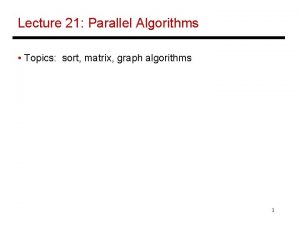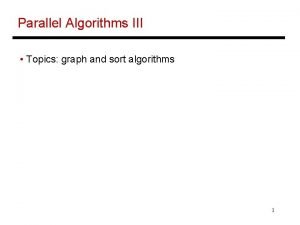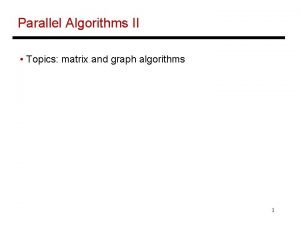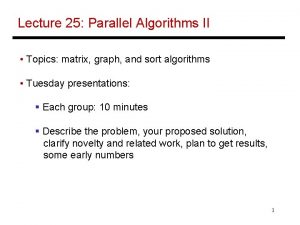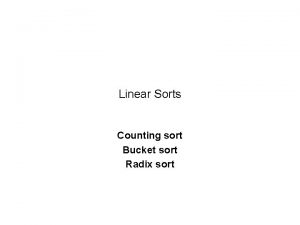Lecture 19 Parallel Algorithms Today sort matrix graph
































- Slides: 32

Lecture 19: Parallel Algorithms • Today: sort, matrix, graph algorithms 1

Matrix Algorithms • Consider matrix-vector multiplication: yi = Sj aijxj • The sequential algorithm takes 2 N 2 – N operations • With an N-cell linear array, can we implement matrix-vector multiplication in O(N) time? 2

Matrix Vector Multiplication Number of steps = ? 3

Matrix Vector Multiplication Number of steps = 2 N – 1 4

Matrix-Matrix Multiplication Number of time steps = ? 5

Matrix-Matrix Multiplication Number of time steps = 3 N – 2 6

Complexity • The algorithm implementations on the linear arrays have speedups that are linear in the number of processors – an efficiency of O(1) • It is possible to improve these algorithms by a constant factor, for example, by inputting values directly to each processor in the first step and providing wraparound edges (N time steps) 7

Solving Systems of Equations • Given an N x N lower triangular matrix A and an N-vector b, solve for x, where Ax = b (assume solution exists) a 11 x 1 = b 1 a 21 x 1 + a 22 x 2 = b 2 , and so on… 8

Equation Solver 9

Equation Solver Example • When an x, b, and a meet at a cell, ax is subtracted from b • When b and a meet at cell 1, b is divided by a to become x 10

Complexity • Time steps = 2 N – 1 • Speedup = O(N), efficiency = O(1) • Note that half the processors are idle every time step – can improve efficiency by solving two interleaved equation systems simultaneously 11

Gaussian Elimination • Solving for x, where Ax=b and A is a nonsingular matrix • Note that A-1 Ax = A-1 b = x ; keep applying transformations to A such that A becomes I ; the same transformations applied to b will result in the solution for x • Sequential algorithm steps: § Pick a row where the first (ith) element is non-zero and normalize the row so that the first (ith) element is 1 § Subtract a multiple of this row from all other rows so that their first (ith) element is zero § Repeat for all i 12

Sequential Example 2 4 -7 3 6 -10 -1 3 -4 x 1 x 2 = x 3 3 4 6 1 2 -7/2 3 6 -10 -1 3 -4 x 1 x 2 = x 3 3/2 4 6 1 2 -7/2 x 1 3/2 0 0 1/2 x 2 = -1/2 0 5 -15/2 x 3 15/2 1 2 -7/2 x 1 3/2 0 5 -15/2 x 2 = 15/2 0 0 1/2 x 3 -1/2 1 2 -7/2 0 1 -3/2 0 0 1/2 x 1 3/2 x 2 = 3/2 x 3 -1/2 1 0 -1/2 0 1 -3/2 0 0 1 x 1 -3/2 x 2 = 3/2 x 3 -1 1 0 0 0 1 1 2 -7/2 0 0 1/2 -1 3 -4 x 1 x 2 = x 3 3/2 -1/2 6 x 1 -3/2 x 2 = 3/2 x 3 -1/2 x 1 -2 x 2 = 0 x 3 -1 13

Algorithm Implementation • The matrix is input in staggered form • The first cell discards inputs until it finds a non-zero element (the pivot row) • The inverse r of the non-zero element is now sent rightward • r arrives at each cell at the same time as the corresponding element of the pivot row 14

Algorithm Implementation • Each cell stores di = r ak, I – the value for the normalized pivot row • This value is used when subtracting a multiple of the pivot row from other rows • What is the multiple? It is aj, 1 • How does each cell receive aj, 1 ? It is passed rightward by the first cell • Each cell now outputs the new values for each row • The first cell only outputs zeroes and these outputs are no longer needed 15

Algorithm Implementation • The outputs of all but the first cell must now go through the remaining algorithm steps • A triangular matrix of processors efficiently implements the flow of data • Number of time steps? • Can be extended to compute the inverse of a matrix 16

Graph Algorithms 17

Floyd Warshall Algorithm 18

Implementation on 2 d Processor Array Row 3 Row 2 Row 1 Row 3 Row 2 Row 3 Row 1/2 Row 2/1 Row 2 Row 3/1 Row 1/3 Row 1 Row 2/3 Row 3/2 Row 3 Row 1 Row 2 Row 1 Row 3 Row 2 Row 1 19

Algorithm Implementation • Diagonal elements of the processor array can broadcast to the entire row in one time step (if this assumption is not made, inputs will have to be staggered) • A row sifts down until it finds an empty row – it sifts down again after all other rows have passed over it • When a row i passes over the 1 st row, the value of ai 1 is broadcast to the entire row – aij is set to 1 if ai 1 = a 1 j = 1 – in other words, the row is now the ith row of A(1) • By the time the kth row finds its empty slot, it has already become the kth row of A(k-1) 20

Algorithm Implementation • When the ith row starts moving again, it travels over rows ak (k > i) and gets updated depending on whethere is a path from i to j via vertices < k (and including k) 21

Shortest Paths • Given a graph and edges with weights, compute the weight of the shortest path between pairs of vertices • Can the transitive closure algorithm be applied here? 22

Shortest Paths Algorithm The above equation is very similar to that in transitive closure 23

Sorting with Comparison Exchange • Earlier sort implementations assumed processors that could compare inputs and local storage, and generate an output in a single time step • The next algorithm assumes comparison-exchange processors: two neighboring processors I and J (I < J) show their numbers to each other and I keeps the smaller number and J the larger 24

Odd-Even Sort • N numbers can be sorted on an N-cell linear array in O(N) time: the processors alternate operations with their neighbors 25

Shearsort • A sorting algorithm on an N-cell square matrix that improves execution time to O(sqrt(N) log. N) • Algorithm steps: Odd phase: sort each row with odd-even sort (all odd rows are sorted left to right and all even rows are sorted right to left) Even phase: sort each column with odd-even sort Repeat • Each odd and even phase takes O(sqrt(N)) steps – the input is guaranteed to be sorted in O(log. N) steps 26

Example 27

The 0 -1 Sorting Lemma If a comparison-exchange algorithm sorts input sets consisting solely of 0’s and 1’s, then it sorts all input sets of arbitrary values 28

Complexity Proof • How do we prove that the algorithm completes in O(log. N) phases? (each phase takes O(sqrt(N)) steps) • Assume input set of 0 s and 1 s • There are three types of rows: all 0 s, all 1 s, and mixed entries – we will show that after every phase, the number of mixed entry rows reduces by half • The column sort phase is broken into the smaller steps below: move 0 rows to the top and 1 rows to the bottom; the mixed rows are paired up and sorted within pairs; repeat these small steps until the column is sorted 29

Example • The modified algorithm will behave as shown below: white depicts 0 s and blue depicts 1 s 30

Proof • If there are N mixed rows, we are guaranteed to have fewer than N/2 mixed rows after the first step of the column sort (subsequent steps of the column sort may not produce fewer mixed rows as the rows are not sorted) Each pair of mixed rows produces at least one pure row when sorted 31

Title • Bullet 32
 Analysis of algorithms lecture notes
Analysis of algorithms lecture notes Introduction to algorithms lecture notes
Introduction to algorithms lecture notes Bubble sort vs selection sort
Bubble sort vs selection sort Difference between selection sort and bubble sort
Difference between selection sort and bubble sort Annyt
Annyt Disadvantage of insertion sort
Disadvantage of insertion sort Nnn sort
Nnn sort Heap sort vs quick sort
Heap sort vs quick sort Bubble sort vs selection sort
Bubble sort vs selection sort Quick sort merge sort
Quick sort merge sort Quick sort merge sort
Quick sort merge sort Radix sort vs bucket sort
Radix sort vs bucket sort Radix bucket sort
Radix bucket sort 01:640:244 lecture notes - lecture 15: plat, idah, farad
01:640:244 lecture notes - lecture 15: plat, idah, farad Pram
Pram Simd parallel algorithms
Simd parallel algorithms Parallel and distributed algorithms
Parallel and distributed algorithms Parallel image processing algorithms
Parallel image processing algorithms Topological sort演算法
Topological sort演算法 Incrementalizing graph algorithms
Incrementalizing graph algorithms Elementary graph algorithms
Elementary graph algorithms Undirected graph algorithms
Undirected graph algorithms For today's meeting
For today's meeting Today is class
Today is class Proposal kickoff meeting agenda
Proposal kickoff meeting agenda Galton details
Galton details Today's lesson or today lesson
Today's lesson or today lesson Example of repitition
Example of repitition Bubble sort parallel programming
Bubble sort parallel programming Control flow graph for bubble sort
Control flow graph for bubble sort Control flow graph for bubble sort
Control flow graph for bubble sort Topological sort unique
Topological sort unique Graph topological sort
Graph topological sort






